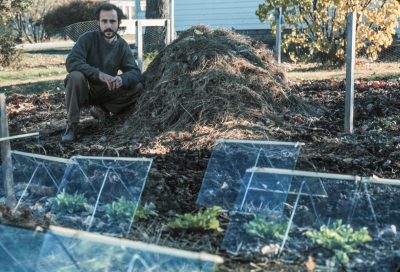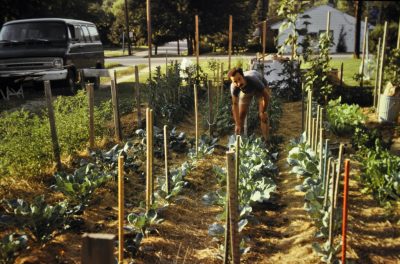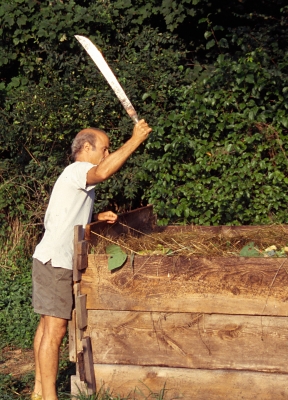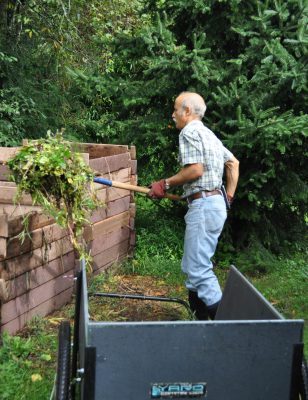To Shred or Not To Shred, That is the Question
Organic Matters
My friend Margaret Roach (https://awaytogarden.com) is a top-notch gardener but not much of a tool maven. She recently said she considers me, and I quote, “the master of all tools and the king of compost” when she asked for my thoughts on compost shredders. (I blushed, but perhaps she was just softening me up for questioning. In fact, her tractor is better than mine.)
Of course I have thoughts about compost shredders.

Climb with me into my time machine and let’s travel back to the early 1970s, to Madison, Wisconsin, where you’ll find me working in my first garden. Like any good organic gardener, early on I appreciated the many benefits of organic materials in the garden, an appreciation bolstered by my having recently began my studies as a graduate student in soil science.
I was hauling all the organic materials I could lay hands on into my 700 square foot vegetable garden. From near where I parked on the agriculture part of campus I could load up large plastic garbage cans with chicken or horse manure for my compost piles.
Also for my compost piles, and for mulch, was tall grass mowed by road crews along a major roadway, easily scooped up with my pitchfork and packed into those garbage pails. Nowadays, gathering such mowings would be difficult because the flail mowers now used chop everything up rather than lay down the long stalks of yesteryears’ sickle bar mowers. Gathering roadside mowings may also now be illegal. And, in retrospect, those mowings were (and still are) probably contaminated with lead and other heavy metals from nearby traffic.

Garden, Madison, 1970s
Anyway, I now have my own one acre field which I scythe and brush hog for mulch and feeding compost piles.
Bulk and Speed
But I digress . . . Margaret was asking about compost shredders.
One benefit of organic materials in gardening is their bulk; they are mostly carbon, hydrogen, and oxygen, which, over time, ends up as carbon dioxide and water. That decomposition is a good thing because it represents the feeding of soil life and, as decomposition proceeds, plant nutrients are slowly released into the soil.
A downside of all that bulk is that it takes up a lot of space. The decomposition rate is influenced by the materials’ ratios of carbon to nitrogen, inhibitors such as lignin, and particle size. A given volume of smaller particles has greater surface area, accessible to being nibbled away by microbes, than does that same volume of larger particles. Like perhaps many beginning gardeners, I was in a rush to have better soil than the sticky clay I was dealing with.
Enter garden shredders. I headed down to the local Sears Roebuck and Company and purchased a new, gasoline-powered shredder. Back in the garden, I set it up and in little time was reducing large volumes of leaves to smaller volumes of shreds.
That activity probably lasted about 20 minutes before two thoughts entered my head. First, one reason I was gardening was because it was — or could be — good for the environment. I could grow vegetables more sustainably that most farmers of the day, and the vegetables would not have to be transported to me. Shredding seemed, then, a waste of energy. Second, the chugging of the engine didn’t seem to jive with a bucolic activity such as gardening. Fortunately, the shredder could be returned; I packed it up and got my money back. (Unless powered by solar, wind, or some other renewable energy source, and electric shredder also spews carbon dioxide et al. It just does so elsewhere.)
And anyway, there’s no particular need, generally, to speed up the composting process. If you need some finished compost immediately because of poor planning or a beginning garden, there are plenty of places where you can purchase good quality compost. Build a couple or more piles of your own, manage them well, and you’ll have “black gold” always ready in due time.
Solar Enters the Picture
I do still occasionally use a compost shredder — but it’s very quiet and it’s solar powered.

Also very inexpensive because it’s nothing more than a machete. If I’m piling very rough material such as corn or kale stalks, or very airy material such as old tomato or pepper plants, or large fruits such as overgrown zucchinis onto my compost pile, I’ll chop them with a machete as I add them. (It’s also therapeutic: If everyone spent some time chopping their compost ingredients, as needed, with a machete, the world would perhaps be a more peaceful place.)

The bottom line is that there’s no reason that you must shred any material for composting. That is, unless it’s absolutely necessary to speed things up or reduce their volume. Is it really necessary? Usually not.


Do you have compost bin plans available?
This should help: https://leereich.com/2019/06/my-compost-for-a-bin.html
I use an electric lawn mower to reduce my fall leaves but I apply directly to the soil as mulch. Does this meet your criteria? I don’t have a lot of extra space to devote to a compost pile.
Yes. That’s very good for the lawn.
Have you run into the worms everyone seems to be worried about? Any thoughts?
Seems they would break down compost faster.
I did see those those worms once on part of my property but they seemed to have left.Yes, they probably do break down compost faster but that’s not necessarily a good thing.
it’s not a very cold winter with temps seesawing on either side of 32*f and occasionally getting down to 10. I’ve been “stockpiling” kitchen waste but my container is near full and frozen. How do you deal with compostable waste in winter?
Here’s something I wrote for Fine Gardening awhile back: https://www.finegardening.com/article/composting-in-cold-weather
Thank you, Lee! Now I do not feel guilty about not shredding. I have been using a three bin system since the early 70s and I am not overly careful about the ratio of green to brown. I still get compost. If it is too rough for how I am using it, I sift through a homemade sieve. I find large pieces when I turn it from bin to bin, I throw the large stuff back. Eventually it all works out.
Yes! Perfect!
You are very funny, Lee (aka Mr. Machete, which is now my other name for you).
Thanks. That machete, by the way, is 40 years old!
Occasionally I wish I had a chipper for brush/branches from trees…But haven’t purchased or rented one…yet. Occasionally a road crew will give us a truck load of just chipped wood but that’s not a given or a regular event. Sometimes we buy a load but again…that’s not regular.
I agree except that it seems that one chipper for one garden is too much. One chipper for a number of gardens, if it could be worked out, seems more sensible. Our local recycling center chips brush that you bring there. You don’t get the chips though. Then again, even if you have a lot to chip, the amount of chips you get from your own prunings is quite small.
Is treated wood safe for compost bin or is there an otherwise preferred wood or material?
I believe it to be safe, but I use “manufactured wood” such as that used for decking. I describe it at https://leereich.com/2019/06/my-compost-for-a-bin.html
I would like either a battery powered or hand cranked shredder to grind up stalks and leaves for layering over the beds in my community garden. I have no room for a large compost pile and the management tends to frown on that kind of composting since we have a problem with rodents. I do have a machete but physical problems make it difficult for me to chop things like tough stalks. I still have sunflower stalks laying in my garden from 2 years ago; doesn’t look like they will break down anytime soon. Wish I could build my dream shredder. Good soil additives and purchased compost is very expensive.
Thanks for your blog, Lee. Very informative….
Years ago a friend bought a hand powered shredder. It was very slow going to shred anything. Soil additives? Like what. The onlh thing most people need is limestone, whichis cheap.
Thanks for all the history in this compost post! I perked up when I read you attended the U.W. back a few years. 🙂 I grew up there and always had a family garden. Now I have much more land a bit north of there, but have to garden in sand. This will be our third year but never seem to have enough compost in the 1/4 acre garden, or 2-acre orchard. My mowing tractor has three bags on the back so I’m always looking for green grass, and leaves from last Autumn. I add all summer but also dump plenty on the 3′-wide beds at the end of each year. Hopefully, we’ll stay here long enough so that I can reap what we’ve sown. Thanks for your teaching. I like to learn, even at my age. 🙂
Most important, especially in sandy soils, is to preserve the soil organic matter. You did’t mention whether or not you till. If you do, STOP! That burns up the organic matter too quickly. Just lay organic materials on top of the ground. You perhaps know this. If not take a look at my book WEEDLESS GARDENING.
Except for loosening up the soil for the first time and adding copious amounts of grass/leaves, I don’t till that section again. I am finally getting worms in the soil which tells me that they finally have enough to eat. Hope they multiply like rabbits. Wanna buy my old Troy? 🙂
I sold my Troybilt about 30 years ago.
I sold my Troy Bilt about 30 years ago. Sounds like you’re doing good for your soil.
I have a magnolia tree that I am trying to use the leaves for compost they don’t break down very well so I used sissors to cut them added water and dirt to soften up .not sure if this will compost can’t find info on that.
That method seems very tedious. I would rather let time do the work.
Hi Lee! I’m so grateful to you for sharing such a wealth of information on soil health with the gardening community, and am looking forward to reading so much more in your Weedless Gardening book. In the meantime, I was hoping to get your opinion on multiflora rose. We have a pretty wild and wooly property whose perimeter is very invaded by multiflora rose. We’ve been hacking it back since we moved in a year ago, and have several car-sized piles of its branches here and there, which are not breaking down quickly. We also created a 1,500 sq ft cutting garden which contributes an equivalent volume of spent flowers throughout the spring, summer, and fall. Our next project is to clear a new area for a line of 3-bin compost bins (what we should have done first!) My question to you is, do you recommend we put the effort in to macheteing the multiflora rose piles, or is the chance of restoring the invasion/slowing down decomposition worth just having it hauled away? And also, is my understanding correct that any fresh flower blossoms, leaves, and stems would be regarded as green/nitrogen-rich whereas any dried flowers/stems/foliage would be regarded as brown/carbon-rich material? Thank you so much for your insights. I want to do this right! Thank you!
Not sure of what you’re asking “is the chance of restoring the invasion/slowing down decomposition worth just having it hauled away?” Younger parts of plant have higher N:C ration than older parts (even if the younger parts are dried). But if you are thinking of adding any of those stems to your new compost piles, I’d suggest against it only because they’ll take a long time to decompose, if after macheteing. You could just pile them in some out of the way place to rot away by themselves.
Lee, thank you! So you’d advise against composting the multiflora rose as well as the stems of my spent “cut flowers”? (Dahlias, lisianthus, cosmos, sweet pea, etc.)I wasn’t expecting the latter and just want to make sure I’m clear on what you mean. Thank you!
No, just not to compost the multiflora rose stems.
Thank you, Lee!